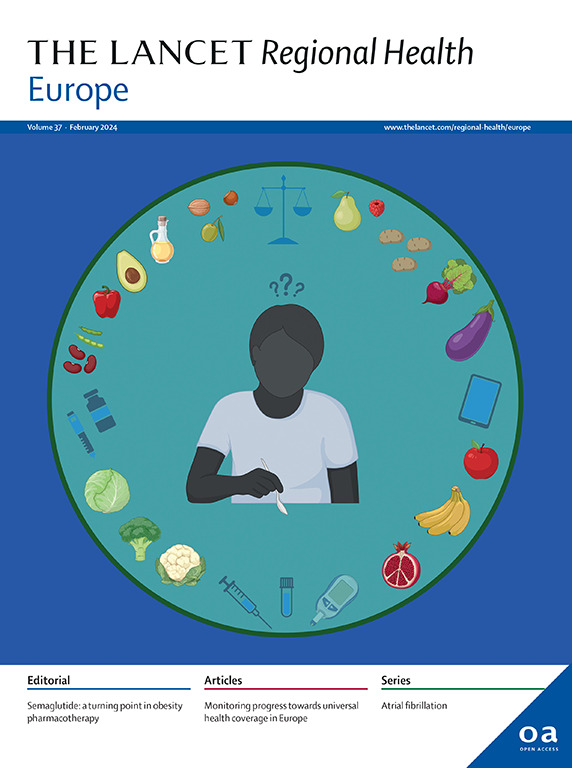Effectiveness of nirsevimab against hospitalisation for RSV-bronchiolitis during high RSV-B circulation in the second year of nationwide implementation in France: a test-negative case-control study
IF 13
Q1 HEALTH CARE SCIENCES & SERVICES
引用次数: 0
Abstract
Background
Nirsevimab was first introduced in September 2023, showing strong real-world effectiveness in preventing hospitalised RSV-bronchiolitis. RSV-A circulation predominated during 2023–2024, whereas RSV-B was frequent in 2024–2025. Recent reports indicated resistance to nirsevimab in RSV-B strains in France. We aimed to assess the effectiveness of large-scale nirsevimab implementation against hospitalised RSV-bronchiolitis during high RSV-B circulation.
Methods
A test-negative case-control study was conducted using a national hospital-based surveillance system. All children <12 months hospitalised for bronchiolitis and tested for RSV in 12 French hospitals from October 10, 2024 to March 15, 2025, were included. Cases were RSV-positive bronchiolitis; controls were RSV-negative bronchiolitis. Effectiveness was assessed by a multivariable logistic regression model adjusted for confounders (sex, gestational age at birth, birth weight, risk factors for severe bronchiolitis, month of diagnosis, and medical centre). A range of sensitivity analyses was conducted.
Findings
1270 patients were included; among which 830 (65.3%) were RSV-positive and 440 (34.7%) were RSV-negative bronchiolitis. The male-to-female sex ratio was 1.35, and the median age was 3 months (IQR: 1.5–5.6). Among cases, 182 (22.0%) received nirsevimab, compared to 282 (64.1%) for controls. Adjusted effectiveness against RSV-bronchiolitis was 84.9% (95% CI, 80.0–88.6). Subgroup analyses by age and severity (intensive care unit admission, respiratory support) showed consistent results, along with sensitivity analyses.
Interpretation
Despite high RSV-B circulation, which has recently been identified to carry mutations potentially inducing resistance to nirsevimab, the effectiveness of the second national nirsevimab campaign against hospitalisation for RSV-bronchiolitis remained high.
Funding
The study received financial support from Sanofi, AstraZeneca, and the 2023 ATIP-Avenir grant from the National Institute of Health and Medical Research (Inserm).
在法国全国范围内实施的第二年,尼瑟维单抗对RSV-B高循环期间rsv -细支气管炎住院治疗的有效性:一项检测阴性的病例对照研究
nirsevimab于2023年9月首次推出,在预防住院rsv -细支气管炎方面显示出强大的实际有效性。RSV-A型以2023-2024年为主,RSV-B型以2024-2025年为主。最近的报告显示,法国的RSV-B毒株对尼瑟维单抗有耐药性。我们的目的是评估在RSV-B高循环期间大规模实施nirseimab治疗住院rsv -细支气管炎的有效性。方法采用全国医院监测系统进行检测阴性病例对照研究。研究纳入了2024年10月10日至2025年3月15日期间在法国12家医院因毛细支气管炎住院并接受呼吸道合胞病毒检测的所有12个月儿童。病例为rsv阳性细支气管炎;对照组为rsv阴性毛细支气管炎。通过调整混杂因素(性别、出生胎龄、出生体重、严重细支气管炎的危险因素、诊断月份和医疗中心)的多变量logistic回归模型评估有效性。进行了一系列敏感性分析。结果:纳入1270例患者;其中rsv阳性830例(65.3%),rsv阴性440例(34.7%)。男女性别比为1.35,中位年龄为3个月(IQR: 1.5-5.6)。在这些病例中,182例(22.0%)接受了nirsevimab治疗,而对照组为282例(64.1%)。针对rsv -细支气管炎的调整有效率为84.9% (95% CI, 80.0-88.6)。按年龄和严重程度(重症监护病房入院、呼吸支持)进行的亚组分析显示出一致的结果,以及敏感性分析。尽管RSV-B的高流通量,最近已被确定携带可能诱导耐药的突变,但第二次全国nirsevimab运动对rsv -细支气管炎住院治疗的有效性仍然很高。该研究得到了赛诺菲、阿斯利康的资金支持,以及美国国家卫生与医学研究所(Inserm)的2023年ATIP-Avenir资助。
本文章由计算机程序翻译,如有差异,请以英文原文为准。
求助全文
约1分钟内获得全文
求助全文
来源期刊

Lancet Regional Health-Europe
Multiple-
CiteScore
19.90
自引率
1.40%
发文量
260
审稿时长
9 weeks
期刊介绍:
The Lancet Regional Health – Europe, a gold open access journal, is part of The Lancet's global effort to promote healthcare quality and accessibility worldwide. It focuses on advancing clinical practice and health policy in the European region to enhance health outcomes. The journal publishes high-quality original research advocating changes in clinical practice and health policy. It also includes reviews, commentaries, and opinion pieces on regional health topics, such as infection and disease prevention, healthy aging, and reducing health disparities.
 求助内容:
求助内容: 应助结果提醒方式:
应助结果提醒方式:


